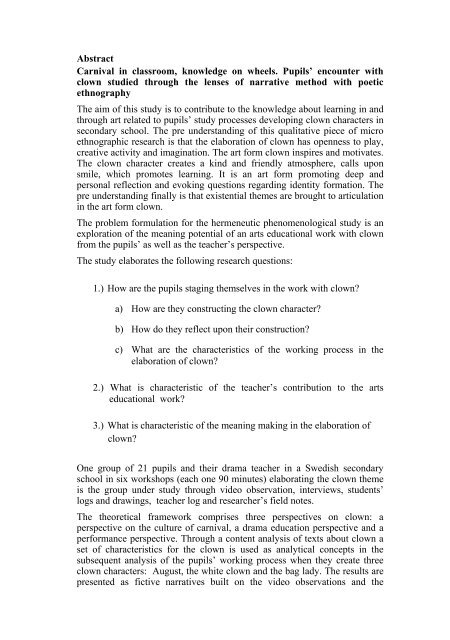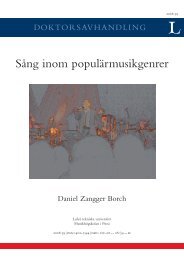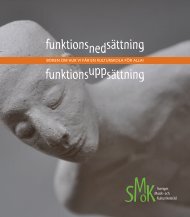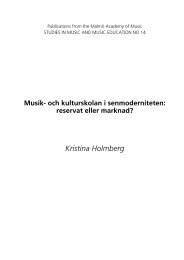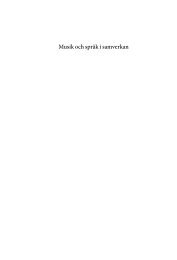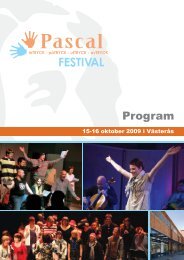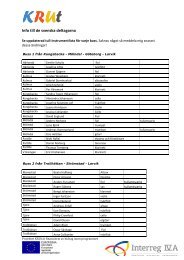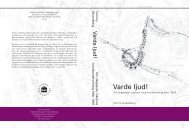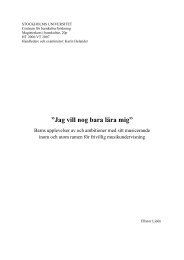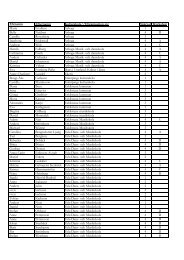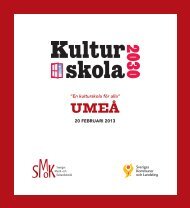- Page 1 and 2: Birgitta Silfver KARNEVAL I KLASSRU
- Page 4: KARNEVAL I KLASSRUM - KUNSKAP PÅ H
- Page 7: CIP Cataloguing in Publication Silf
- Page 12 and 13: INNEHÅLL Förord Figurförteckning
- Page 14 and 15: 4 Meningsskapande i elevernas clown
- Page 16 and 17: FIGURFÖRTECKNING Figur 1. Clownarb
- Page 18 and 19: 1 INLEDNING Den här avhandlingen h
- Page 20 and 21: 1.2 Tankar om clownen Clownen är h
- Page 22 and 23: den tid man mest är upptagen av de
- Page 24 and 25: vår syn på det som kan komma att
- Page 26 and 27: Rita Irwin skriver i förordet 5 ti
- Page 28 and 29: Fenomenologi har fokus på fenomen.
- Page 30 and 31: Clownen i skolan hör hemma under d
- Page 32 and 33: 2 TEORETISK REFERENSRAM Detta kapit
- Page 34 and 35: komiska gestalterna som Shakespeare
- Page 36 and 37: clown (engelska, antingen ett ord a
- Page 38 and 39: enskild funktion beskrivs. Min avsi
- Page 40 and 41: Cirkusclownen Under Shakespeares ti
- Page 42 and 43: 2.1.2 Clownens funktioner Avgränsn
- Page 44 and 45: 2.1.5 Ifrågasättaren Åsa Mälham
- Page 46 and 47: Det enkla cirkustänkandet; Han som
- Page 48 and 49: (Silfver, 2005: 45). Clownen som vi
- Page 50 and 51: Gestalten är skamfilad och missfö
- Page 52 and 53: 2.2.2 Karnevalen är livet som fest
- Page 54 and 55: (Cox, 1969). Jag - Du kan inte hell
- Page 56 and 57: efter en publik. Han har en längta
- Page 58 and 59:
skolkultur. Med en svag bindning ge
- Page 60 and 61:
Inkeri Sava (1995), som forskar ino
- Page 62 and 63:
fler erfarenheter som han kan anvä
- Page 64 and 65:
passar väl tillsammans med multimo
- Page 66 and 67:
skolan? Vilka gränser överträds?
- Page 68 and 69:
Det finns många sätta att visa si
- Page 70 and 71:
3 METOD I metodkapitlets första de
- Page 72 and 73:
elevens kunskapsbyggen. Ställninge
- Page 74 and 75:
människan tar för given i sina va
- Page 76 and 77:
komma fram till en slutledning (ded
- Page 78 and 79:
3.3 Narrativ metod Den narrativa fo
- Page 80 and 81:
dikter om elevernas clowner, samtid
- Page 82 and 83:
erättade vad arbetet skulle bestå
- Page 84 and 85:
Sminkning inför gruppen: En elev b
- Page 86 and 87:
eller en person i taget. Det finns
- Page 88 and 89:
handlingen, loopar i en utveckling,
- Page 90 and 91:
konsistens (växlingen mellan del o
- Page 92 and 93:
Saga, berättelse och diktsvit föl
- Page 94 and 95:
som clowner tolkar jag mimik, kropp
- Page 96 and 97:
Figur 4. Scener med august och aspe
- Page 98 and 99:
(japansk kortdikt) som i koncentrer
- Page 100 and 101:
Motstridiga känslor Titta! Nu stic
- Page 102 and 103:
verkstaden gått omkring med den r
- Page 104 and 105:
Klas (jag är finurlig) Karin (vill
- Page 106 and 107:
Slagsmål gestaltades både av flic
- Page 108 and 109:
makt och hur man försvarade sin ma
- Page 110 and 111:
Triangeldrama Modellen Alex är en
- Page 112 and 113:
Det vrenskande paraplyet Modellen C
- Page 114 and 115:
Modellen Greta är klädd i svart g
- Page 116 and 117:
Matrisen i figur 6 är en sammanfat
- Page 118 and 119:
upp. Det individuella meningsskapan
- Page 120 and 121:
Stämningen är svårdefinierad. De
- Page 122 and 123:
Lär: Gammal Elev: Han har bott på
- Page 124 and 125:
lev nöjd när han hittade peruken.
- Page 126 and 127:
låter sig inte bevekas utan går d
- Page 128 and 129:
han åt iväg åt ett annat håll o
- Page 130 and 131:
Klas har satt sig upp. Han tar till
- Page 132 and 133:
Jag drar häftigt efter andan. Hän
- Page 134 and 135:
Figur 8. Mönster i clownarbete med
- Page 136 and 137:
Också ställföreträdaren finns m
- Page 138 and 139:
Alans agerande skapar kontrast till
- Page 140 and 141:
den blindes arm och följaktligen
- Page 142 and 143:
Figur 10. De centrala aspekterna f
- Page 144 and 145:
aderna kallas kusiner, närbesläkt
- Page 146 and 147:
gestalta sig på vitt skilda vis i
- Page 148 and 149:
4.4.4 Mönster i mötesdikterna Dik
- Page 150 and 151:
Blyg tjej blåser upp ballong. Fias
- Page 152 and 153:
Glad generad grabb Alla öron spets
- Page 154 and 155:
Vandrare Rastlös Sätter slokhatt
- Page 156 and 157:
Erik leker med sexualitet. Han har
- Page 158 and 159:
tillåtande atmosfären. Den stundt
- Page 160 and 161:
5 ELEVERNAS REFLEKTIONER KRING ISCE
- Page 162 and 163:
är med folk som man tycker om och
- Page 164 and 165:
kände igen mig i. Lite så där pr
- Page 166 and 167:
var ganska spännande eftersom man
- Page 168 and 169:
6 LÄRARENS ERFARENHET AV CLOWNARBE
- Page 170 and 171:
som arbetspartners. Mellan flickorn
- Page 172 and 173:
Gemensamma övningar improvisatione
- Page 174 and 175:
6.4.2 Förtäljer Läraren förtäl
- Page 176 and 177:
Läraren tillåter experimenterande
- Page 178 and 179:
didaktikens växling mellan modell
- Page 180 and 181:
den andre har ägt rum i det egna k
- Page 182 and 183:
Överlevnad och den kraft som finns
- Page 184 and 185:
andlighet diskuteras sällan. Hade
- Page 186 and 187:
åde episteme, techne och fronesis.
- Page 188 and 189:
använt mig av perspektivtrianguler
- Page 190 and 191:
POSTLUDIUM Jag kliver ut i äventyr
- Page 192 and 193:
Young teenagers comprise my researc
- Page 194 and 195:
In my own definition of clown, the
- Page 196 and 197:
Whiteface clown, and the Tramp/Hobo
- Page 198 and 199:
• Work with the clown has an open
- Page 200 and 201:
The learning that occurs in the car
- Page 202 and 203:
Bogdan, R. &. Biklen (2003). Qualit
- Page 204 and 205:
Hanson, N. R. (1958). Patterns of D
- Page 206 and 207:
Nationalencyklopedin. Hämtat från
- Page 208 and 209:
Säll, E. (2000). Lärarrollens oli
- Page 210 and 211:
BILAGOR Bilaga 1. Brev till föräl
- Page 212 and 213:
Att svinga sig över 121 Gå in i v
- Page 214 and 215:
Man kunde vara kreativ 137 En lady
- Page 216 and 217:
när jag var den clownen. Jag känd
- Page 218 and 219:
13. Augustclownen var bäst. Den va
- Page 220 and 221:
vara så här glada och så plötsl
- Page 222 and 223:
allongerna. Det gjorde jag för att
- Page 224 and 225:
12.( (Hjälp av kompisar.) Nej. 13.
- Page 226 and 227:
som jag vill bli och så. (Gillar)
- Page 228 and 229:
(clownerna) var mest för tjejer. D
- Page 230 and 231:
11. Man ser olika sidor hos sig sj


